edible INDY
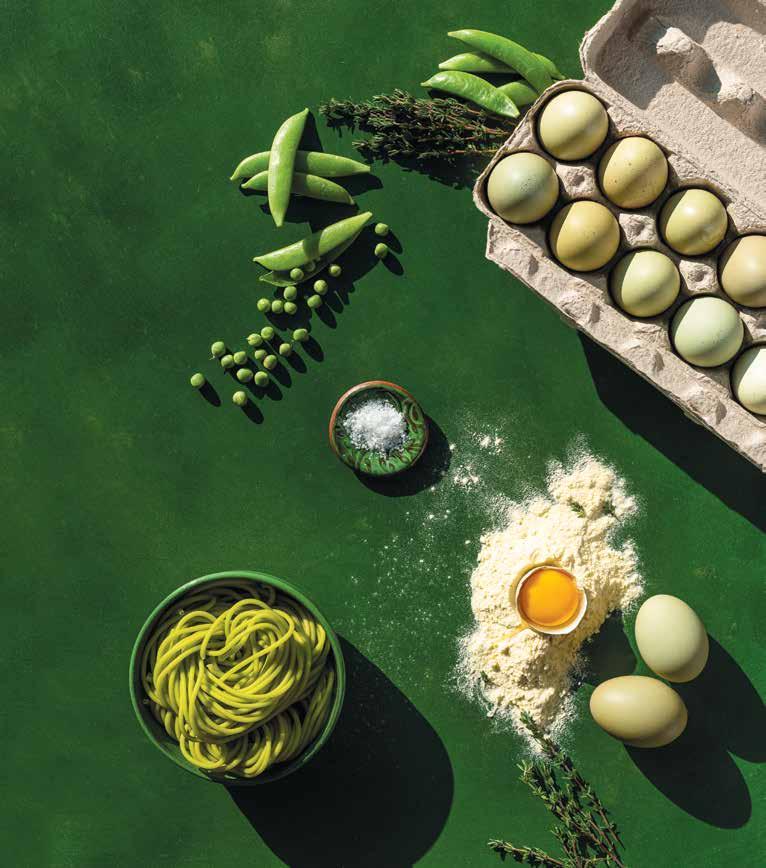






EXCLUSIVE CONTENT
Scan QR code to find exclusive online stories, events and recipes for every season.












Scan QR code to find exclusive online stories, events and recipes for every season.




It evokes so many emotions, generates vivid memories, gives us hope and fills us with the desire to sing out loud, to cry waterfalls and even to dance like no one is watching. As we were looking for themes to center our stories around for this issue, we found ourselves picturing songs that went along with the stories. The aha! moment occurred when we realized much in this issue was about pride, and much more was about joy… and so it was: “Pride and Joy” won us over.

Whether you are listening to “Pride and Joy” by Stevie Ray Vaughn, by Marvin Gaye or by Brandi Carlile, all three songs share in the story of a love. Love is what this issue revolves around. The love of making pasta. The love of blooming bouquets that give you peace. The love of giving back to the community or giving back to the earth that in return gives back to you. Each story is filled to the brim with pride, passion and the desire to showcase what we believe is a new season of rebirth, curiosity and hopefulness.
I especially want to thank Tony and Rosa Hanslits, who have been instrumental within the Indianapolis food scene. From working closely with a plethora of brilliant chefs to taking time to work with Second Helpings to creating some of the most delectable pasta and dishes this side of Italy, thank you for allowing us to share in your adventures and we wish you all the best as you start your new one. And yes, we have asked the mayor for a parade in your honor… still waiting to hear back.
And on a side note, the color green is intentional throughout the issue. It represents growth, renewal, harmony and hopefulness. All perfect representations of an Indiana spring.
With gratitude and hope,

Jennifer Rubenstein 2023 Indiana Grown Commission Board Member
Want to advertise with us?
Reach out to me personally at jennifer@edibleindy.com.
I wish I could say my garden is my pride. It isn’t—not yet. But it is my joy. I am a newbie gardener. I inherited the garden last spring as-was from the previous owners when we bought our house. It was an amazing and diverse garden, full of flowers and blooms. I embarked on a steep learning curve to figure out what to do in summer, fall and winter last year. Now I am waiting to see if those tulips I planted by my apple trees will come up, if the plum and cherry trees survived my pruning attempts, and if those tomato seeds I am about to plant will yield me some harvest later this summer. One thing is for sure: I am framing Lynsey Johnston’s inspirational piece about all the things you can grow to pick abundant bouquets from your own garden—and not least because it is so beautiful!
With pleasure,

Francine Spiering
Scan to play our Pride & Joy Spotify Playlist. It includes three Pride & Joy songs and a few others to put spring in your step.
photograph: Marissa Molloy

PUBLISHER
Rubenstein Hills LLC
EDITOR IN CHIEF
Jennifer L. Rubenstein jennifer@edibleindy.com
CHIEF FINANCIAL OFFICER
Jeff Rubenstein
MANAGING EDITOR
Francine Spiering
COPY EDITOR
Doug Adrianson
DESIGN
Cheryl Koehler
SALES
jennifer@edibleindy.com
CONTACT US
Have a story you’d like to see featured? Send us your ideas. editor@edibleindy.com
EDIBLE INDY PO Box 155
Zionsville, IN 46077 p. 260.438.9148
SUBSCRIBE
Edible Indy is published four times per year. Subscriptions are $32 and available at EdibleIndy.com
EDIBLE INDY PO Box 155
Zionsville, IN 46077 p. 260.438.9148
Every effort is made to avoid errors, misspellings and omissions. If, however, an error comes to your attention, then you probably have not had enough wine with your healthy food! Please accept our sincere apologies and, if it’s important, please notify us. Thank you. No part of this publication may be used without written permission from the publisher. © 2023 all rights reserved.
Member of Edible Communities









Central General Store offers food where it’s needed words: Kristian DePue | photography: Lissa Smith Photography LLC
You’re likely familiar with the sidewalk bookcases known as Little Free Libraries— wooden boxes atop a post, just big enough to showcase books free for any passersby to pick from. Now there’s another growing grassroots movement: small neighborhood pantries available for those experiencing food insecurity. A couple of these little public pantries operate in Indianapolis with support from Elizabeth Friedland’s Central General Store.
Friedland is a Hoosier, native to Circle City, who spent a few years in the Big Apple. “New York is amazing, but not practical,” she says. “Indianapolis is accessible. There’s opportunity to get hooked in, even for newcomers. Indy has the space and welcoming environment to empower people. If you want to do something, you can make a mark.”
Friedland works in the communications field but has been intentionally involved in various social causes. She identifies as a humanitarian and makes moves that speak true to that—promoting women’s rights, volunteering with foster care services and adopting a child.
“It’s important: supporting people,” she continues. “If everybody looked around and asked, ‘What are three things I can do this year to help my neighbor?’ our world would be transformed.”
So, what is the Central General Store? Inspired by Future Farmers of America, Friedland planted two Little Free Pantries for people to pull from as needed, and the Central General Store is the hub that supplies and operates them.
“I’ve always wanted to have a food pantry to tangibly give back,” Friedland says. “I grew up with a single mom. We never had to utilize a pantry or rely on public assistance. However, even as a kid, I knew we were on the edge and I grew up very aware of others who had less.”
Brandi Davis-Handy, a donor and volunteer, got involved after seeing an image online. “Elizabeth posted a picture on social media showing a line of people at the New York Street pantry only moments after stocking it,” says Davis-Handy. “Through that image, it was clear there’s a need here.”
The pantry on East New York Street stands on the property of Cornerstone Lutheran Church, near the sidewalk.
“I reached out to Elizabeth after learning she was seeking a second site for her Central General Store,” says Sarah Diaz, member of Cornerstone Lutheran. “Our church was aware many of our neighbors were facing food insecurity, and this seemed like a great opportunity. We host a pantry inside, but the Central General Store provides access at all hours.”
Jason Taber, Cornerstone’s pastor of outreach, also praises the pantry: “Our members are very supportive. Its value is evident by the struggle to keep it stocked. Every time we fill it, it’s empty within hours. Clearly, it’s meeting a need in our community.”
Friedland has goals to grow the Central General Store, with a vision to add at least four more pantries and a board of directors.
“I’m working towards improved, sustainable sourcing. And ultimately, I want to make this a true nonprofit,” says Friedland. “There are organizations we want to partner with. The more connections we make, the better we can be by strengthening each other. It’s a grassroots endeavor demanding to go to the next level. The need is much greater than I imagined.”
Simply donating food directly to a pantry site is one way to get involved. However, there are other opportunities, such as volunteering to manage a pantry for a day.
“Elizabeth is working to make Indianapolis better,” says DavisHandy. “If more people get involved by taking small actions, we can help our neighbors in ways you can’t imagine.” n
Central General Store pantries can be found at 5151 Central Ave. and 2837 E. New York St. For more information, visit centralgeneralstore.org and littlefreepantry.org.
Instagram: @centralgeneralstore
Born and raised in rural Indiana, Kristian DePue has worked as a contributing writer for several years. After residing in colorful Colorado for a few years, he’s happy to be a Hoosier again.

“If everybody looked around and asked, ‘What are three things I can do this year to help my neighbor?’ our world would be transformed.”
—Elizabeth Friedland

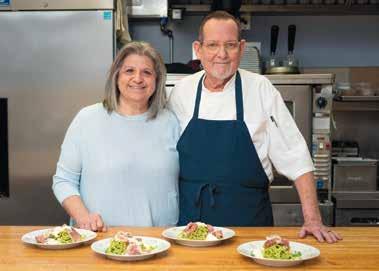
Beloved culinary couple Tony and Rosa Hanslits to conclude 40-year legacy in Circle City
words: Brian Garrido | photography: Elizabeth Hanna Studios




Ihad never been inside Indianapolis’s legendary pasta emporium Nicole-Taylor’s Pasta + Market + Backroom Eatery. After living in Indianapolis for three years, I drove by the unassuming SoBro location sandwiched between a fitness studio and a cupcake shop.
When I popped into the Italian shop dedicated to everything bel paese (Italian for beautiful country) on a winter’s day, it felt like I had stepped into a local alimentari (Italian grocery) I once frequented in Montefalco, a tiny medieval town in Umbria, Italy.
Scrumptious memories rallied to the forefront as I circled the big wooden table laid out with regional goods. Attractive bottles of olive oil lined the shelves with cans of tuna packed in oil. A half dozen varieties of bottles of balsamic vinegar. Roasted peppers jarred prettily. Imported Marzano tomatoes. An array of distinctively different cheeses and fresh housemade pasta lined the deli cases. While I was wrapped tightly against the frigid air outside, the inside of the market adorned in Tuscan yellow felt warmed by the Mediterranean sun. Then, Rosa Hanslits appeared from the back, welcoming me like a nonna (Italian grandmother), arms spread wide for a hug.
Inarguably, Rosa and Tony Hanslits are food royalty in Indianapolis. Since the mid-1980s, Tony either opened or worked in more than half a dozen area restaurants while Rosa parlayed her Italian heritage into a fresh pasta mini empire. Additionally, Tony was the director of culinary education of The Chef’s Academy, a school dedicated to creating homegrown chefs. While it only lasted for a decade, The Chef’s Academy, a division of the now-closed Harrison College, offered bachelor and associate degree programs in culinary arts and hospitality. It was the first of its kind in the city and within Indiana’s university system, with a regional campus in Raleigh, North Carolina. By the time the accredited program ended in 2018, approximately 425 students had enrolled and more than 200 graduated with more than 90 percent of graduates obtaining employment.

Rosa took me to the appropriately named Backroom Eatery located behind the retail area. The walls along the passage were lined with magazine and newspaper clippings, detailing the lengthy career of Rosa and her husband, Chef Tony Hanslits. Full-page stories from old local magazines to the current local daily newspaper and even Edible Indy decorated the space. It’s a literal framed history of the Hanslits’ life in food; in truth, four decades of Circle City dining as well.
As we sat at one of the bar tables waiting for Tony, the matriarch of Indy’s fresh pasta began. “We love Indianapolis. It’s been our home for 40 years, but it’s time for us to start a new chapter.”
The new era for the couple means packing up and moving to North Carolina, where their two daughters reside, Ashley Nicole and Katherine Taylor, after whom the business was named. They’re looking for a management team to run the daily operations as they seek new options for themselves. “It’s going to be hard, but, in the same breath, I can also say that it’s going to be a happy time for us.” Rosa’s eyes began to tear. “We can spend time with our girls. We can be grandparents.”
At about this time, Tony came ambling over in his chef’s coat, dusted with flour and tomatoes. “Rosa always wanted to do a market,” he says, “and that’s what kind of drove the restaurant. It was a passion of ours.”
At 65, Chef Hanslits moves slower, less sure of his body. For years now Tony has been suffering from multiple illnesses including kidney disease. Chef had his first transplant in 2003. “I’m getting ready to go back on dialysis someday soon,” he reports, scuttling up on the barstool. “As soon as they tell me. I got a transplant 20 years ago, and it’s starting to fail. It’s preventive maintenance to go into dialysis while they search for a new kidney donor.” It was after one of his surgeries and a year sabbatical that they decided to rethink the future, Rosa says. “And… that’s how we started selling our fresh pastas at (area) farmers markets.”
In 1989, noted Italian food journalist Carlo Petrini started Slow Food, a movement founded to protect and preserve local food cultures and traditions. Around the same time, Tony and Rosa became part of Indianapolis’s culinary and cultural legacy by implementing locally sourced ingredients, one of the Slow Food tenets. Tony began his rise to kitchen stardom, working with restaurateur Peter George of Peter’s restaurant. For four and a half years, he toiled in Fountain Square before opening other eateries, including Something Different and 14 West. Sharing Petrini’s and eco-conscious opposition to big agriculture and farming, Tony and Rosa for the next 40 years rolled out restaurants that still resonate today. Chef Tony, with his Johnson & Wales culinary arts degree, essentially advocated the Slow Food movement throughout his career, furthering gastronomy to burgeoning Midwest chefs of all ethnic and socioeconomic backgrounds.
“Chef Tony Hanslits has been a key player in the local restaurant scene since he was the opening chef at Peter’s in 1985,” says Hoosier food writer Jolene Ketzenberger. “That’s almost 40 years, an incredible run for anybody in the restaurant biz. He’s trained other chefs, both at The Chef’s Academy as well as in his own kitchens, including the still-missed Tavola Di Tosa.”
Of course, Rosa’s Italian background instigated their culinary pursuits. While raised in Northern Indiana’s “the region,” she was born in the Reggio Calabria region, the “toe” of Italy. A “kick away” from Sicily, the area is home to Calabrian chili, bergamot, nduja sausage and the hand-rolled raschiatelli, a long tubular noodle. Her family moved to South Bend, where she eventually met Tony.
While Tony was behind the scenes battling stoves, sous chefs and sauces, Rosa built community markets such as Tosa Café, the addendum to their restaurant. Rosa spearheaded the farmers trade and direct sales to consumers for their pastas, right up to today where she oversees the edible stock in the shop and the local distribution of pasta to many surrounding restaurants and markets.
The couple created a delicious life in Circle City. Importantly, their legacy will be remembered as bringing fresh Italian pasta to Naptown and mentoring many Hoosier chefs working today. They helped pioneer the careers of Bluebeard’s Abbi Merriss, Steven Oakley, Erin Kem of Scarlet Lane, and Neal Brown, from Neal Brown’s Hospitality.
“Chef Tony was my original ‘chef’ in terms of being a first mentor,” said Brown in an email. “He was innovating Italian food around the same time Mario Batali brought elevated Italian to the forefront at Babbo. I would submit, Chef was cooking at the same and maybe even a higher level during their time at Tavola di Tosa.”
Nicole-Taylor’s Pasta + Market + Backroom Eatery opened in the summer of 2009. “He and Rosa also built a loyal clientele for their fresh pasta at farmers markets and then opened a great little shop,” says Ketzenberger. “A terrific lunch spot as well. And their chef dinners around their big kitchen prep table became such a hit that they started selling out a year in advance.”
As we chatted in their dining area, I watched a young man sitting in front of a pasta extruder in an area marked “Pasta Room” with large letters over the door. He deftly swiped about two inches of something tubular. I’ve only met this dynamic duo of the kitchen and feel connected to them. I feel a sense of grief that Indianapolis will lose not only great food but also real icons and neighbors.
“Tony and Rosa have been so influential in my career and in the local food community for as long as I’ve known them,” said Brown. “They have championed the regional specialties in Italian cooking like no one has before or since. I love that they are such a good and fun team too. They’re high-quality people who have raised two great girls and a gondola full of cooks and hospitality pros. Indy owes them a monument.” n
Nicole-Taylor’s Pasta + Market + Backroom Eatery 1134 E. 54th St., Indianapolis NicoleTaylorsPasta.com
Brian Garrido has written food stories for LA Weekly, Clever Root and DailyMeal.com. He moved to Indy from Los Angeles with two dogs and his partner, Nick.
The walls along the passage were lined with magazine and newspaper clippings, detailing the lengthy career of Rosa and her husband, Chef Tony Hanslits. Full-page stories from old local magazines to the current local daily newspaper and even Edible Indy decorated the space. It’s a literal framed history of the Hanslits’ life in food; in truth, four decades of Circle City dining as well.

In November 2022, people lined up in the darkness of the morning (as they have for over 13 years) to wait in line to secure one of the coveted 2023 Chef’s Table reservations. And as it has every year, it sold out in a few hours. The Chef’s Table will continue through 2023 in a capacity that will be determined as the journey for Tony and Rosa becomes clearer. As with life itself, change is inevitable. With management, chef and hostess changes, the Chef’s Table and Nicole-Taylor’s Pasta + Market may take on a new life… only time will tell.

Pasta recipes full of love, kindness and pleasure
recipes: Tony Hanslits | photography: Elizabeth Hannah
4 servings
2 cups 00 flour (plus more for dusting)
5 egg yolks
Semolina flour, for dusting
Opposite: Stunning bowls provided by Gravesco Pottery (GravescoPottery.com).
Beautiful oil bottle provided by A Question of Eagles AQuestionofEagles.com
To mix the dough: Mound the flour in the center of a large, wide mixing bowl or on a table. Make a well in the center of the flour mound and add the 5 egg yolks. Using a fork, beat together the eggs and incorporate the flour, starting with the inner rim of the well. The dough will come together in a shaggy mass when about half of the flour is incorporated.
Use your fingers to continue to mix the dough. Press any loose bits of flour into the mass of dough. Sprinkle the mixture with a little water if needed to absorb all the flour. Once the dough comes together into a cohesive mass, transfer to a lightly floured surface and knead by hand for 7 to 10 more minutes, until the dough is smooth, elastic and uniform in color. Place the dough in a lidded container and refrigerate for 30 minutes.
To form the pasta: Line 3 baking sheets with parchment paper and lightly dust with semolina flour. Set aside.
Cut off a quarter of the dough and roll it into a ball. (Keep the remaining dough covered and let it rest until you are ready to use it.) Use the palm of your hand to flatten the dough ball into an oval approximately the same width as your pasta machine, about 6 inches. Set the rollers to their widest setting and pass the dough through.
Lay the dough out onto a lightly floured cutting board or countertop and neatly fold in thirds, so it is again about the width of the pasta machine. Feed the pasta through again at the widest setting. Think of these first rollings as an extended kneading. Continue to fold the dough in thirds and roll it until it is smooth, silky and evenly textured. Do your best to make the sheet the full width of the machine between each rolling.
Once the dough is silky and smooth, you can begin to roll it out more thinly. Roll it once through each of the next two or three settings, dusting with flour as needed.
Once the pasta is about ¼ inch thick, begin rolling it twice through each progressively smaller setting. As you roll, lightly sprinkle all-purpose or 00 flour on both sides of the pasta to prevent it from sticking. Roll out pasta until you can just see the outline of your hand when you hold it under a sheet, about 1⁄16 inch thick for fettuccini noodles.
Dust the sheets lightly with semolina flour, stack on one of the prepared baking sheets and cover with a clean kitchen towel. Repeat with remaining dough. Fettuccine can be made easily by cutting the rolled-out pasta sheets into ¼-inch-wide strips with a knife. (To make bucatini you will need a special die or extruder.)
Similar to the Basic Pasta recipe but without eggs, this green, plant-based recipe substitutes pea purée for the egg yolks.
FOR THE PEA PURÉE
2 teaspoons extra virgin olive oil
½ cup diced onion
1½ cups fresh or frozen peas
1½ cups water
2 sprigs thyme
¼ teaspoon salt
1 teaspoon baking soda
FOR THE PASTA
2½ cups 00 flour (plus more for dusting
1 recipe pea purée (above) Semolina flour, for dusting

To make the pea purée: Heat the olive oil over low heat, add the diced onion and sweat until soft. Add the peas to the onion and cook for 2 minutes. Add water, thyme, salt and baking soda to the pea and onion mixture. Increase the heat and bring to a simmer for 3–5 minutes or until mixture thickens. Remove thyme sprig, cool and purée.
To make the pasta: Mound the flour in the center of a large, wide mixing bowl or on table. Make a well in the center and add pea purée. Using a fork, incorporate the flour, starting with the inner rim of the well. The dough will start to come together in a shaggy mass when about half of the flour is incorporated. Use your fingers to continue to mix the dough. Press any loose bits of flour into the mass of dough. Sprinkle with a small amount of water if needed to absorb all the flour. Once the dough comes together into a cohesive mass, transfer to a lightly floured surface and knead by hand for 7 to 10 more minutes, until the dough is smooth, elastic and uniform in color. Place the dough in a lidded container and refrigerate for 30 minutes.
Continue to form the pasta according to the Basic Pasta instructions on page 11.





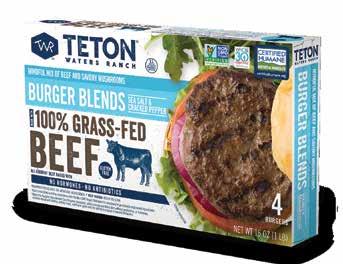

Make this delighful spring pasta recipe any way you like—use mint instead of basil; replace the butter with your favorite extra virgin olive oil; or even use store-bought pasta. While fresh peas make this recipe sing, frozen peas (cooked first according to the package directions) work fine.
4 servings
1 recipe Pea Pasta (see page 12) formed into bucatini or fettuccini
½ cup chopped parsley + extra for serving
½ cup chopped basil
2 tablespoons chopped chives
Salt and pepper, to taste
1 teaspoon crushed red pepper flakes
7 tablespoons salted butter, melted
2 cups freshly shelled spring peas
4 ounces sliced prosciutto, torn in small pieces
8 ounces burrata cheese, torn
Extra virgin olive oil, for drizzling
Bring a large pot of salted water to a boil. Once boiling, add the pasta and cook until al dente, 2–3 minutes. Drain pasta and place in large mixing bowl. Add the chopped parsley, basil and chives. Add a generous pinch of salt and pepper and crushed red pepper flakes. Pour melted butter and the peas in with the pasta noodles and season with additional salt and pepper, if desired. Toss to combine. Transfer noodles to a large serving bowl (or plate individually) and distribute prosciutto and burrata on top. Drizzle with olive oil and sprinkle with additional chopped parsley.


Inventing remarkable yet simple bouquets
words: Lynsey Johnston | illustration: Claire Le Moing
Bouquets can be poetic inspiration tapping into all our senses season to season. Did you know many fruits, herbs and vegetable flowers can be used to enhance a bouquet with their fragrances, textures and unique shapes? Growing these bouquet ingredients in your own secret garden will provide ever-changing floral splendor while you learn to fill your garden with multiple-purpose plants. Get creative and invent your own remarkable bouquets.
The best flowers for bouquets have long and sturdy stems, but the most uniquely beautiful bouquets are created by using interesting edibles and finding ways to incorporate plants already growing in your yard.
Incorporate these herbs and vegetable flowers in your one-of-a-kind bouquets:
❧ Dill
❧ Elderberry flowers
❧ Chives, common or garlic
❧ Variegated pineapple mint
❧ Basil, such as Blue Spice
❧ Common or variegated sage
❧ Amaranth, such as Velvet Curtains
❧ Chicory (any variety flowers in year 2)
❧ Overwintered Brassicas, such as lacinato kale
❧ Okra, such as Okinawa Pink or Alabama Red
❧ Woody shrub cuttings from landscape prunings of lilac, hydrangea, boxwood, holly, ninebark
❧ Invasive species you can feel good about cutting: autumn olive and Asian bush honeysuckle
❧ Prunings from flowering apple or stone fruit trees
❧ Pussy willow cuttings
❧ Elderberry blooms


❧ Use clean snips or scissors to harvest. Clean snips with alcohol to prevent the spread of disease.
❧ Harvest in the early morning or evening to prevent wilting.
❧ Harvest 12- to 15-inch stems.
❧ Bring a vessel filled with water to immediatelysubmerge the stems.
❧ Remove any leaves that will be submerged in vase water.
❧ Use a product like Floralife Flower Food to extend the life of your cut flowers, or make your own extender with ¼ teaspoon of bleach per quart of vase water.
❧ Dill—Used in Ayurvedic medicines and loved by pollinators.
❧ Zinnia “Zinderella”—Best beginner flower. Long blooming and loved by butterflies.
❧ Cock’s Comb—Flowers, leaves and stems are edible and can be used to create natural dyes.
❧ Hyacinth Bean Pods—Both pods and flowers make a beautiful addition to a bouquet.
❧ Blue False Indigo—Excellent option for heavy wet clay soil. “Australis” is an Indiana perennial native.
❧ Dahlia—Edible tubers. Shorter versions work well in pots.
Peaceful & Practical Edible Gardens was born from the combined love of gardening, food and design.
Founded by Lynsey Johnston, P&P reimagines how we source our food, while maintaining beautiful and bountiful landscapes. Lynsey is fascinated by the possibility that food can grow anywhere, that a few seeds can provide enough food for multiple families and that a deeper understanding of plants and nature has the power to change our lives.

P&P is active in the community, teaching folks how to responsibly create and care for their gardens, build spaces and grow healthy food. They have a keen focus on caring for the earth, centering ethical principles of permaculture and educating the community. P&P works with home gardeners and community gardens in the Indianapolis area, and serves clients on a national scale through virtual support. Their services include edible garden design, installation and maintenance, and workshops and coaching.
Do you want to reconnect with nature and redesign your space, while growing your own healthy food?
Learn more at PeacefulandPracticalGardens.com
Follow on Instagram @peacefulpracticalgardens
And in case you are wondering: Yes, lime trees can grow in Central Indiana. Lynsey Johnston is the owner of Peaceful & Practical Edible Gardens, a permaculturist and Hamilton County Master Gardener. Lynsey is a mother to two future gardeners (fingers crossed!) and two rescue dogs. In between all things gardening, she is turning an old monocrop field into a food forest with her father-in-law at their family’s homestead in NE Indiana. Follow her on Instagram at @pandpgardens
Spring:
Refresh soil with compost as needed.
Sow annual flowers.
Plant perennial flowers. Mulch beds.
Harvest overwintered Brassica flowers.
Summer:
Deadhead flowers
Manage garden pests. Pull weeds.
Observe your plants’ health.
Take notes on what has done well in your garden.
Purchase fall-planted tubers, bulbs and corms. Fertilize.

SPRING BLOOMS
• Iceland poppies • Tulips • False Queen Anne’s Lace
• Bells of Ireland • Ranunculus • Sweet Peas
• Chocolate Lace Flower • Yarrow • Chives
• False Blue Indigo
Fall:
Plant tubers, bulbs and corms such as tulips, ranunculus, daffodils.
Dig and lift dahlia tubers and other non-hardy bulbs and store for winter.
Sow seeds of hardy annuals.
Add compost or soil amendments as needed.
Plant perennial flowers.
Refresh mulch around perennials.
Winter:
Purchase seeds and spring-planted bulbs.

SUMMER BLOOMS
• Zinnia • Sage • Lavender • Dahlias • Okra
• Blue Spice Basil • Cockscomb • Runner beans • Dill
• Purple Hyacinth Bean • Daylily
Local:
Habig Garden Shop, Westfield & Indianapolis Habiggardenshop.weebly.com
Forest Flower, Indianapolis Theforestflower.com
Central Indiana Seed Swap, Noblesville
Local Purdue Master Gardeners’ spring plant sales Purdue.edu/hla/sites/master-gardener/events
Native Plants Unlimited, Fishers Nativeplantsunlimitedshop.com
Perennials Plus, Westfield Perennials-plus.com
Online:
Johnny’s Selected Seeds Johnnyseeds.com/flowers
Floret Flowers Shop.floretflowers.com
Swan Island Dahlias Dahlias.com
Colorblends Wholesale Flower Bulbs Colorblends.com
Holland Bulb Farms Hollandbulbfarms.com
It matters. The majority of Central Indiana falls into Zone 5b or Zone 6a. Scan to find your exact zone.


FALL BLOOMS
• Sunflower • Black Eyed Susan • Ornamental grass plumes
• Italiko Rosso Dandelion • Sedum (Stonecrop Purple Emperor or Thunderhead cultivars) • Dahlia

• Daffodils • Overwintered Brassicas, such as kale

Ethiopian center creates growth opportunities for youth
words: Julie Yates | photography: courtesy Felege Hiywot Center
Felege Hiywot Center grows both crops and character. Felege hiywot means “looking for direction to life” in Ge’ez, an ancient Ethiopian Semitic language. FHC helps junior and senior high students find exactly that in its RISE initiative, an employment- and agriculturebased STEAM (science, technology, engineering, art, math) program.
Students are encouraged to apply lessons learned from urban farming and community service into strategies to meet all of life’s challenges. Although FHC had a humble beginning, it is now a strong force not only in preparing individuals for the future but also in building a sense of place.
Nestled in Martindale-Brightwood, FHC serves an ever-changing population of youth. In the 1870s the historic near-northeast Indianapolis locale was two distinct areas: Martindale was home to segregated African Americans and Brightwood was inhabited with first-generation German and Irish railroad workers. Today the population is mostly African American along with a slight Latino and Caucasian representation.

“In Ethiopia, elders are our library. They may tell the same story over and over, but each time we hear it, we learn something new.”
—Aster Bekele, Felege Hiywot Center founder
As a young college student living in the neighborhood in the 1970s, Aster Bekele was grateful for the opportunities she had before her, but never lost sight of the culture she left when she emigrated from Ethiopia.
“In Ethiopia, elders are our library,” she says. “They may tell the same story over and over, but each time we hear it, we learn something new.” While heeding her inward call to contribute to the community by tutoring some of the area schoolchildren, she had a dual realization: working with youth and connecting with elders goes hand in hand. Those two concepts formed the focus when she founded FHC.
“I want to build on the rich history of the MartindaleBrightwood elders I met and keep it alive by engaging the students we serve by asking them to interview their grandparents or any elders they know in their community.”
Over the years, the programming offered has been flexible to meet the needs of the area’s changing demographics while remaining true to the traditions of values on which it was founded. Initially a boarded-up property on which two rundown houses sat, the center now supports multiple outdoor garden plots, a small greenhouse and a polytunnel greenhouse.
In 2021, FHC was awarded a $2 million grant to be disbursed over five years from Lilly Endowment, Inc., through its initiative Enhancing Opportunity Indianapolis. The grant supports RISE, an acronym for the mission of the program: Resilience and drive; Inquiry and ingenuity; Social impact; and Economic security.
“We don’t assume that students come to us already knowing how to do things,” says Bekele. “We meet them where they are. We mix the teams with three groups: those that have leadership experience, those in the middle and those that don’t have that experience yet. The students follow the scientific method to find answers to their inquiry. When using the scientific method, they may have to circle back to step one, but nothing is considered a mistake—only learning.
“Job requirements at FHC are unique,” she continues. “We want their innovation ideas on how to accomplish a task. So engaging their minds and teamwork is required. One example from summer camp 2022 was, after training on

time management and teamwork, we gave them a task to figure out how to fill 60 raised beds with 27 cubic yards of blended soil. They had three days to finish. They had an option to use our detailed instruction or come up with their own. They decided to put their heads together and come up with a plan.
“On the first day of the plan, they managed to fill six beds and some half beds. At the end of the day, we took them through a calculation of the time it took them to fill the beds and, based on that, they would need 16 hours more to do the rest of the beds, which meant they wouldn’t meet their goal. They regrouped and talked on how to put each student on the task they were properly fitted with. On the second day they did 10 beds, which means still they wouldn’t be ready to plant by the fourth day. They did more discussion on improvement and on the third day they did 44 beds, accomplishing their goal.
“FHC jobs require mind engagement. As scientists we are getting paid to discover new ways of doing things and we want students to experience that,” says Bekele.
In their horticulture investigations, students follow another acronym. The word PLANTS is used to teach the basic needs of all the center grows. All growing things require Place, Light, Air, Nutrients, Thirst (water) and Soil.
“Students each get an individual planting bed. Nothing is a failure; it’s all a learning experience,” says Hope Staton, farm instructor/manager. “The garden zones are taught along with what grows in our climate at the time. Information is given on what can be done to push it such as the polytunnel or ground cover. Students develop a plan, chart a time frame of what they expect to happen and why.”
The students follow the scientific method to find answers to their inquiry. When using the scientific method, they may have to circle back to step one, but nothing is considered a mistake—only learning.
”I’m never going to say no to students’ desire to grow vegetables we haven’t grown before,” Staton says with a chuckle. “I’ve spent hours searching out dwarf lemon seeds on Etsy. I’m also looking for tangerine and dragon fruit. It will be an interesting experiment.”
Staton, who is originally from Virginia and working towards her master’s in divinity degree, came to Indiana to attend Bethany Theological Seminary, located in Northwest Indiana. Before that, she was in the Brethren Volunteer Service.
“I came because I had a calling to the ministry, but not necessarily as a pastor. I became involved with FHC to teach Junior Master Gardening plus health and nutrition. When I was asked to take the position of farm instructor/manager, I couldn’t pass it up,” says Staton. “People think teenagers aren’t interested in farming, but that’s not true. Give them the opportunity to have space and not label anything as a failure, they will jump through hurdles.”
When the students are not gardening, a portion of the day is devoted to teaching core skills such as positive mind-sets, work ethic and learning strategies as well as social and emotional skills. The skill sets taught involve resume writing, interview coaching





In their horticulture investigations, students follow another acronym. The word PLANTS is used to teach the basic needs of all the center grows. All growing things require Place, Light, Air, Nutrients, Thirst (water) and Soil.
and entrepreneurial concepts. Students are encouraged to plug everything, even disappointments and relationship development, into the scientific method.
“It is lovely to have families here. When we have events that include them, Ms. Aster makes wonderful Ethiopian food. She spends a whole week cooking it,” says Staton. It is always a feast of stewed meats, lentils and vegetables fragrant with spices and served with injera, Ethiopia’s staple fermented teff bread.
FHC relies on volunteers. They are always needed, and Bekele refers to them as “our lifeline.” There is plenty of work to be done from maintenance of the facility to farm weeding. Unfortunately, during COVID volunteer program dropped to zero and the farmers market ceased operations. Both are currently being brought back to life.
The application process for FHC’s summer camp begins in early spring and the program begins the second week in June. Information is posted online at AfterSchoolHQ.com and word of mouth is spread by already-participating families. Most students return year after year; alumni stay connected and return to do university research.
“Past graduates come in the last day of camp to tell their story,” says Bekele.
“Students can see how far they have come. The key is persistence and not giving up. Whatever the struggle is, they learn to hold on and always connect to their roots.
“It is a gift to guide somebody,” she continues. “It doesn’t matter where you go; you are always carrying someone’s hand with you to push you forward. It is alright to leave and love a new place, but never disconnect from where you came from.” n
Felege Hiywot Center
1648 Sheldon St., Indianapolis FHCenter.org

Through a partnership with Purdue University’s Botany and Plant Pathology department, FHC students learn to identify plant parts and describe them through drawing.
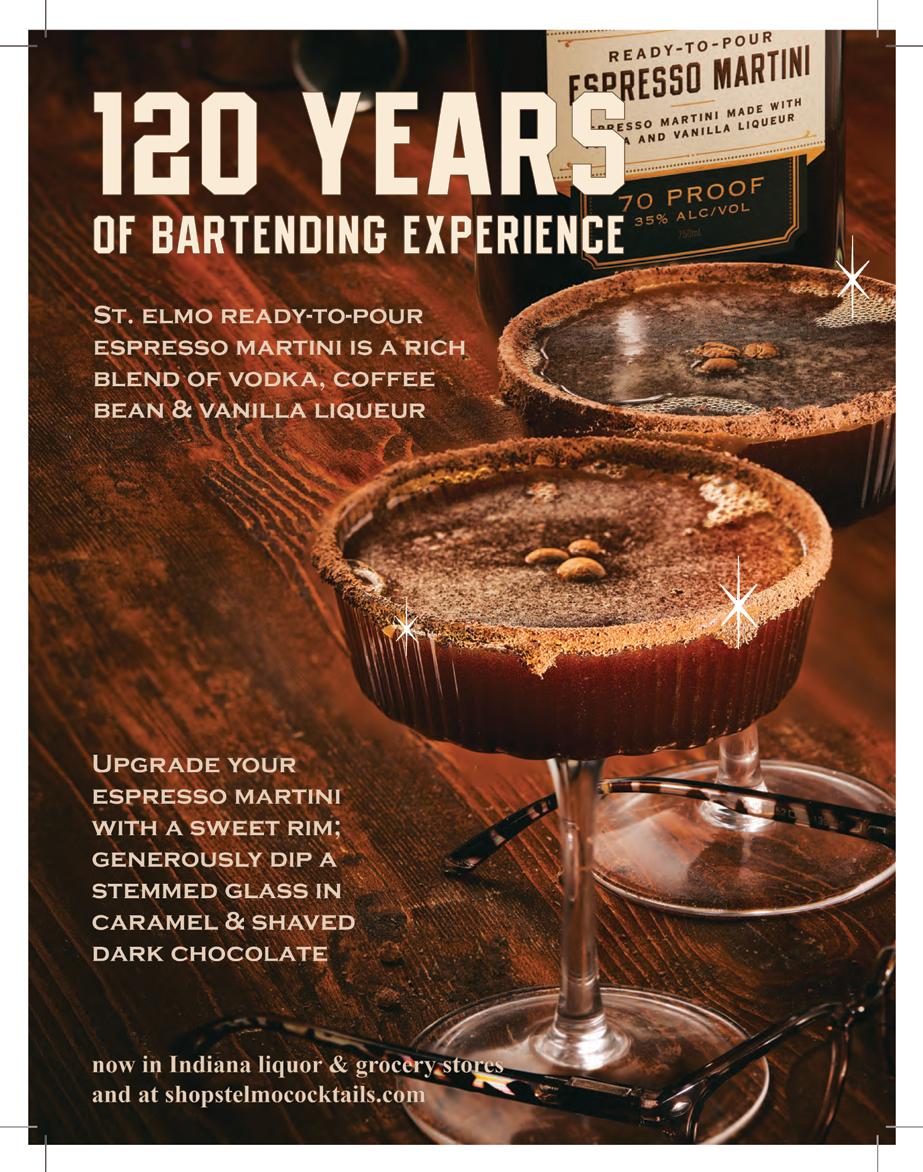

words: Audrey Baron
Do you feel yourself coming alive when spring begins to show herself? This feeling reminds us that we are connected to the natural rhythms of the earth. We begin to spring up in a sense when the earth is waking from her slumber. Our spring medicines are also waking up and peeking out from the soft earth to bask in the sun’s rays and bring us nourishment and healing.
Our wild foods, especially in the spring, bring such potent nourishment and medicines. It’s as though they understand we have been cooped up, missing the sun and eating heavier foods. Herbs such as dandelions, violets and cleavers bring deep nourishment and remedies to support the lymphatic system, the liver, kidneys, blood and more.
Note: In picking any ingredient, especially those that are wild, please be aware of the chemicals that may be in the dirt or on the plant.
Dandelion (Taraxacum officinale) is one of my most-used herbs and a great one to start with because just about everyone can identify a dandelion and she grows just about everywhere. Her yellow blooms begin to show up in early spring in yards, fields and along the roads. These sun-like flowers are one of the first foods for pollinators and one of the first wild foods for those who forage.
The leaves and roots of the dandelion are where the strong medicine really comes in. The leaves can be harvested most anytime, but they are most tender and delicious in the spring. You can add the leaves to salads, into soups or even juice or add to a smoothie. Dandelion leaves are highly mineral-rich and have a diuretic effect, moving the internal waters of the body. They can also be made into a tea to soothe and brighten the skin.
Dandelion roots can be harvested in spring or fall and are my favorite part of the plant to use. Every fall, I bring my root harvest into the kitchen, wash well and chop. I bake at 200°F until the roots are completely dry and have an aroma of chocolate. They can be stored in a glass jar for up to three years and used to make tea that supports the liver and kidneys and beautifies the skin.
First things first: Harvest those dandelion roots! Once you’ve washed and chopped your roots into small pieces, place onto a baking sheet. Bake at 200°F until your kitchen begins to smell like chocolate. Allow to cool and keep your roasted roots in a jar to make the following tea.
2 tablespoons roasted dandelion root
4 cups filtered water
Small cinnamon stick
Pinch of cardamom (or half of a cardamom pod)
Bring the 4 cups of water to a boil, add the dandelion root, cinnamon and cardamom and simmer for 20 minutes. Strain and pour into a mug or allow to cool and add ice.
The purple peppering of the yards in spring, when visited up close, will most likely be the wild violet. (Viola spp.). These sweet flowers are not just for our viewing pleasure, they also offer useful medicine. Violet is known to support the lymphatic system and to help soothe inflammation. One might choose violet when they feel their lymph nodes are swollen (especially around breast tissue) or when they have an inflamed, hot and irritated feeling. This purple beauty could be perfect to help soothe a dry cough and conditions such as bronchitis. Violet also has an affinity for tending to the emotional heart. One can make a tea with both violet leaf and flower. This wildflower is also a food! High in nutrients such as vitamins A, C and magnesium, you can add her flowers and leaves to a salad and enjoy her wild nourishment. You can dry her flowers and leaves and keep in a dark cabinet for up to a year to use for your teas.
On a beautiful spring day get close to the ground and feel the child in you wonder as you harvest each small purple bloom from the violet. You want about a cup of flowers. You receive a bonus if you hum a tune to the flowers while you harvest.
1 cup fresh violet flowers
1 cup raw local honey
Pour half of the honey into a half pint jar and add the violets. Pour the remainder of the honey over the flowers. Set aside for 4–6 weeks near a window or sunlight-filled area to allow the violet flavor to infuse the honey. Do not strain. Use the honey with the flowers in your tea, on toast or by the spoonful.

Do you have a desire to connect to your local community, to local food and plant medicine or have a desire to learn how to start an organic garden?
Wild Moon Acres is a small urban farm 15 minutes from downtown Indianapolis, started by chef and herbalist, Audrey Barron and husband Sam. Established in 2016 and using permaculture and regenerative growing practices to grow fruit trees, elderberry bushes, mushrooms and medicinal herbs.
Offering a variety of programs and workshops centered around herbalism, homesteading, permaculture and more with a mission to provide products and education that support customers in their quest to thrive and live their most vibrant lives.
Wild Moon Acres is open for school field trips and tours.
Find out more at WildMoonAcres.love
Follow on Instagram @wild.moon.acres
Cleavers (Galium aparine) are most known to attach themselves to you with their tiny hairs all over their stems and leaves as you walk past. Some say cleavers may have been the inspiration for the invention of Velcro. This unassuming green plant is my favorite lymphatic mover. She arrives in spring, ready to help get things flowing in the body, moving stagnant energies and toxins. She can easily go unnoticed as she grows along the ground, with the tiniest white flowers, but her ability to get lymph moving is powerful. I like to make tea with her fresh stems and leaves in the spring. Ice cubes made of freshly juiced cleavers can be used throughout the summer, adding to drinks and soups.
Large basket of fresh cleavers
½ cup filtered water 2 tablespoons lemon juice
Run your fresh cleavers through a juicer, giving you the bright green juice of the leaves and stems. Once juiced, add a bit of water to the juice with a squeeze of lemon, stir and pour into ice cube trays. Use the cubes to add flavor to any drink.

words & photography: Francine Spiering
Do you cook from (all) your cookbooks? Beyond trying the recipes, we enjoy our cookbooks for inspiration. Cookbooks bring an exciting cuisine, culture or lifestyle under our eyes. Others are a joy to read for their stories alone, or to dream about the scenes pictured in photographs. A cookbook collection is a pride and joy. Here are some unique cookbooks to add to your collection—if you don’t have them already!
How diverse is the vegetable garden of farm-to-table pioneer chef Alice Waters in Berkeley, California? What does plot-to-plate in minutes mean to a Michelin-star chef like Enrico Crippa in Turin, Italy? This beautifully illustrated garden-green book offers an exquisite peek into the kitchen gardens of famous chefs from all over the world. Each one shares stories about their garden. We learn what it means for a chef to be able to create dishes based on what they grow themselves. While the recipes are quite involved, the book is an inspiration for any kitchen garden grower.


Curated and edited by Bryant Terry, Black Food is a most colorful, insightful and enticing exploration of the culinary histories behind Black food. It results in a stellar collection of essays, poems, photographs, illustrations and recipes that explores not only food and culture, but also important topics like food justice, LGBTQ activism and racial equity. From a recipe for Bajan fish cakes by Sarah Kirnon to okra and shrimp purloo by BJ Dennis, smoked collards by Mashama Baily to Fresh Roberson’s coconut-curry harvest soup, this gem of a book showcases the breadth, wealth and health of African American cuisine. Cover to cover, it leaves us with a deep appreciation for Black food.
If you are looking for a comprehensive and detailed guide to all things fermented, with easy-to-follow instructions, look no further. From kefir to kimchi, shrubs to sauerkraut, author Sharon Flynn writes engagingly about different fermentation techniques and why fermented foods are so good for the gut. To her, the “gurgle of a crock bubbling is a soothing, nurturing and exciting sound.” Flynn moved around the world a lot. She lived in Japan for a decade, where she learned how to make miso and that koji is what boosts that umami. Laced with beautiful photos and illustrations, it’s easy to get absorbed reading about the mothers and SCOBYs, lees and wheys.
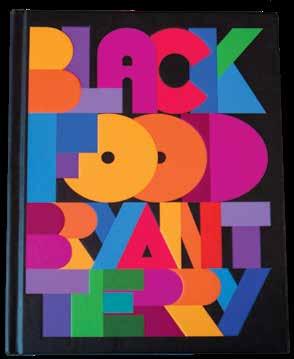

This is a cookbook to gift if ever there was one: It comes in a box that also contains a colorful selection of fragrant spices, dried herbs and spice blends like Royal Berbere and Mauritian Masalé. The recipes offer a scrumptious tour of the world, each one making use of at least one of the spices in the box. Each recipe also gives options. Don’t have squash to make Trinidadian chokha? Make it with eggplant and use coriander seed rather than mustard and whole cumin. You can vary to your heart’s content. Authors Ethné and Philippe de Vienne are fervent spice trekkers who value flavorful yet healthy, light food. You cannot go wrong with a book that offers such tempting recipes—and includes the spices you need to prepare them!

Australian chef Josh Niland wrote a comprehensive cookbook that celebrates fish in a sustainable manner. Not just how it was caught and whether the fish is a green choice, but also about using the whole fish, head to tail, inside and out. The book emphasizes that “cooking only fish fillets is not only creatively limiting but also neglects the majority of the fish.” Especially if you are or know an angler, you will love this book. Fish varieties used in the recipes can be replaced with any that you can find. It is a gorgeously designed book, and one to display with pride. From the essentials of poaching fish to the flavorful combinations of a great fish curry, this is a book that you eat with your eyes. n














Happy little (and not so little) things to mention words: Jennifer L. Rubenstein | photography: Torrie Hudson
“She’s my sweet little thing… She’s my pride and joy…” sang Stevie Ray Vaughn. I pause, breathe deep and give gratitude to just a few things that give me pride and joy as we walk into our Hoosier spring season.
James Beard 2023 Semi-Finalist Nominees: Abbi Merriss, Bluebeard
Samir Mohammad, 9th Street Bistro
For programs and organizations such as the Immigrant Welcome Center empowering Indy’s immigrants to adapt, integrate and thrive. ImmigrantWelcomeCenter.org
For women like Arianna Cruz, founder and creator of MORE magazine (Making Opportunities Reachable for Everyone) focusing on creating content that is valuable and powerful. MoreMagazine.org
Being appointed as a 2023 Indiana Grown Commission Board Member, which gives me the opportunity to advocate for policy change within the food and beverage industry.
Getting flower seeds like Amaranth Hot Biscuits, Chocolate Lace Flower, Zinderella Peach Zinnia and Thai Silk California Poppy from Floret to plant this spring. FloretFlowers.com
For those social butterflies who tag #EDIBLEINDY on their foodie adventures.
And lastly…. my own pride and joy always and forever.

American Farmland Trust, we believe agriculture is strengthened through diversity. Get fresh updates on our work to ensure the future of agriculture includes all Americans. farmland.org


Discrimination against marginalized groups in agriculture negatively affects all Americans by limiting the opportunities for farmers, workers, and consumers.
AFT is raising up diverse voices in agriculture, because we believe diversity contributes to a more resilient agricultural system, a stronger economy, and a more equitable society.

Located in beautiful downtown Bloomington, we are passionate about championing the virtues of good food, drink, and the benefits of gathering around a table. Empowering those who love to cook and those who don’t – our knowledgeable team will walk you through our expansive collection of cutlery, cookware, and tools. We invite you to visit the shop – sample oils, vinegars, chocolate, and jam, wander through our ever-changing collection of linens and ceramics, and connect with us over all things food.
